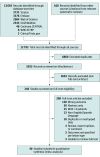Assessment of Diagnostic Accuracy of Dermoscopic Structures and Patterns Used in Melanoma Detection: A Systematic Review and Meta-analysis
- PMID: 34347005
- PMCID: PMC8339993
- DOI: 10.1001/jamadermatol.2021.2845
Assessment of Diagnostic Accuracy of Dermoscopic Structures and Patterns Used in Melanoma Detection: A Systematic Review and Meta-analysis
Abstract
Importance: Dermoscopy increases the diagnostic accuracy for melanoma. However, the accuracy of individual structures and patterns used in melanoma detection has not been systematically evaluated.
Objective: To assess the diagnostic accuracy of individual dermoscopic structures and patterns used in melanoma detection.
Data sources: A search of Ovid Medline, Embase, Cochrane CENTRAL, Scopus, and Web of Science was conducted from inception to July 2020.
Study selection: Studies evaluating the dermoscopic structures and patterns among melanomas in comparison with nonmelanoma lesions were included. Excluded were studies with fewer than 3 patients, studies in languages other than English or Spanish, studies not reporting dermoscopic structures per lesion type, and studies assessing only nail, mucosal, acral, facial, or metastatic melanomas or melanomas on chronically sun-damaged skin. Multiple reviewers applied these criteria, and 0.7% of studies met selection criteria.
Data extraction and synthesis: The Preferred Reporting Items for Systematic Reviews and Meta-analyses reporting guideline and Meta-analysis of Observational Studies in Epidemiology reporting guideline were followed. Guidelines were applied via independent extraction by multiple observers. Data were pooled using a random-effects model.
Main outcomes and measures: The prespecified outcome measures were diagnostic accuracy (sensitivity and specificity) and risk (odds ratio [OR]) of melanoma for the following dermoscopic structures/patterns: atypical dots/globules, atypical network, blue-white veil, negative network, off-centered blotch, peripheral-tan structureless areas, atypical vessels (eg, linear irregular, polymorphous), pseudopods, streaks, regression (ie, peppering, scarlike areas), shiny white structures, angulated lines, irregular pigmentation, and a multicomponent pattern.
Results: A total of 40 studies including 22 796 skin lesions and 5736 melanomas were evaluated. The structures and patterns with the highest ORs were shiny white structures (OR, 6.7; 95% CI, 2.5-17.9), pseudopods (OR, 6.7; 95% CI, 2.7-16.1), irregular pigmentation (OR, 6.4; 95% CI, 2.0-20.5), blue-white veil (OR, 6.3; 95% CI, 3.7-10.7), and peppering (OR, 6.3; 95% CI, 2.4-16.1). The structures with the highest specificity were pseudopods (97.3%; 95% CI, 94.3%-98.7%), shiny white structures (93.6%; 95% CI, 85.6%-97.3%), peppering (93.4%; 95% CI, 81.9%-97.8%), and streaks (92.1%; 95% CI, 88.4%-94.7%), whereas features with the highest sensitivity were irregular pigmentation (62.3%; 95% CI, 31.2%-85.8%), blue-white veil (60.6%; 95% CI, 46.7%-72.9%), atypical network (56.8%; 95% CI, 43.6%-69.2%), and a multicomponent pattern (53.7%; 95% CI, 40.4%-66.4%).
Conclusions and relevance: The findings of this systematic review and meta-analysis support the diagnostic importance of dermoscopic structures associated with melanoma detection (eg, shiny white structures, blue-white veil), further corroborate the importance of the overall pattern, and may suggest a hierarchy in the significance of these structures and patterns.
Conflict of interest statement
Figures
Similar articles
-
Amelanotic/hypomelanotic melanoma: clinical and dermoscopic features.Br J Dermatol. 2004 Jun;150(6):1117-24. doi: 10.1111/j.1365-2133.2004.05928.x. Br J Dermatol. 2004. PMID: 15214897
-
Dermoscopic findings for the early detection of melanoma: an analysis of 200 cases.Actas Dermosifiliogr. 2014 Sep;105(7):683-93. doi: 10.1016/j.ad.2014.01.008. Epub 2014 Apr 3. Actas Dermosifiliogr. 2014. PMID: 24704190 English, Spanish.
-
Dermoscopy, with and without visual inspection, for diagnosing melanoma in adults.Cochrane Database Syst Rev. 2018 Dec 4;12(12):CD011902. doi: 10.1002/14651858.CD011902.pub2. Cochrane Database Syst Rev. 2018. PMID: 30521682 Free PMC article.
-
Clinical and Histopathologic Characteristics of Melanocytic Lesions on the Volar Skin Without Typical Dermoscopic Patterns.JAMA Dermatol. 2019 May 1;155(5):578-584. doi: 10.1001/jamadermatol.2018.5926. JAMA Dermatol. 2019. PMID: 30865233 Free PMC article.
-
Computer-assisted diagnosis techniques (dermoscopy and spectroscopy-based) for diagnosing skin cancer in adults.Cochrane Database Syst Rev. 2018 Dec 4;12(12):CD013186. doi: 10.1002/14651858.CD013186. Cochrane Database Syst Rev. 2018. PMID: 30521691 Free PMC article.
Cited by
-
Multiple Primary Melanoma: A Five-Year Prospective Single-Center Follow-Up Study of Two MC1R R/R Genotype Carriers.Life (Basel). 2023 Oct 23;13(10):2102. doi: 10.3390/life13102102. Life (Basel). 2023. PMID: 37895483 Free PMC article.
-
Risk factors for actinic keratosis, non-melanoma skin cancer and cutaneous malignant melanoma in persons with and without Parkinson's disease: A cross-sectional study.Skin Health Dis. 2024 Oct 4;4(6):e464. doi: 10.1002/ski2.464. eCollection 2024 Dec. Skin Health Dis. 2024. PMID: 39624738 Free PMC article.
-
Deep Learning Techniques for the Dermoscopic Differential Diagnosis of Benign/Malignant Melanocytic Skin Lesions: From the Past to the Present.Bioengineering (Basel). 2024 Jul 26;11(8):758. doi: 10.3390/bioengineering11080758. Bioengineering (Basel). 2024. PMID: 39199716 Free PMC article. Review.
-
Not All Polarized-light Dermatoscopes May Display Diagnostically Critical Polarizing-specific Features.Dermatol Pract Concept. 2022 Oct 1;12(4):e2022250. doi: 10.5826/dpc.1204a250. eCollection 2022 Nov. Dermatol Pract Concept. 2022. PMID: 36534575 Free PMC article. No abstract available.
-
Cutaneous non-volar melanoma dermoscopy and histopathology correlation: a systematic review protocol.BMJ Open. 2025 Jul 8;15(7):e090781. doi: 10.1136/bmjopen-2024-090781. BMJ Open. 2025. PMID: 40633957 Free PMC article.
References
-
- Surveillance, Epidemiology, and End Results Program, National Cancer Institute. Cancer stat facts: melanoma of the skin. Accessed June 27, 2021. https://seer.cancer.gov/statfacts/html/melan.html
Publication types
MeSH terms
LinkOut - more resources
Full Text Sources
Medical
Miscellaneous


